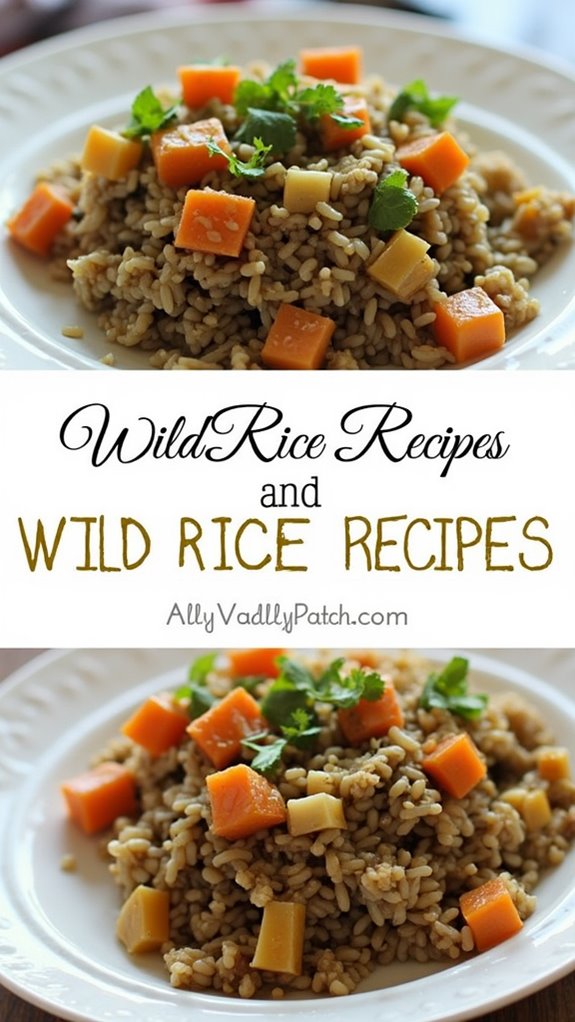Wild Rice Recipes
When you prepare a wild rice salad with roasted vegetables, you’ll notice its nutty flavor and chewy texture elevate the dish. Wild rice is not just delicious; it’s also packed with nutrients and has a rich history that makes it special. In this guide, you’ll discover various ways to use wild rice in your meals. Curious about how to incorporate it into your cooking? Let’s explore some tasty recipes together.
Why You’ll Love This Recipe
When you try this wild rice recipe, you’ll quickly discover why it’s a favorite among many home cooks.
First, the nutty flavor and chewy texture of wild rice makes it a unique and satisfying dish. You can easily pair it with various ingredients, like vegetables, nuts, or proteins, making it versatile for any meal.
Cooking wild rice is simple too; it requires minimal hands-on time while delivering a hearty side or main dish. Plus, it’s packed with nutrients, offering a healthy alternative to white rice.
Whether you’re preparing a cozy family dinner or a festive gathering, this recipe will impress everyone at the table. You’ll appreciate how it complements various cuisines and elevates your cooking game effortlessly.
History
Wild rice has a rich history that dates back thousands of years, particularly among Native American tribes in the Great Lakes region.
These tribes relied on wild rice, or “manoomin,” as a staple food source. They cultivated it using traditional methods, often harvesting it by canoeing through the marshes.
Wild rice played a crucial role in their culture, featuring in ceremonies and celebrations.
As settlers arrived, they recognized the value of wild rice, which became an important trade item.
Today, wild rice continues to be significant for both Indigenous communities and modern cuisine.
Understanding this history is essential, as it enriches your appreciation for wild rice and its role in various cultures.
It’s more than just a food; it’s a tradition.
Recipe

Wild rice is a nutritious and flavorful grain that adds a distinctive taste and texture to a variety of dishes. Its nutty flavor pairs beautifully with a range of ingredients, making it versatile for both savory and sweet recipes. Cooking wild rice is a delightful process that can enhance any meal, providing a unique twist to traditional rice dishes. This recipe will guide you through preparing a delicious wild rice pilaf, perfect as a side dish or even as a main course.
To achieve the best flavor and texture, it’s crucial to rinse the wild rice before cooking. This helps remove any residual dust and guarantees that the grains cook evenly. Wild rice takes longer to cook than white rice, but the result is well worth the wait. With its chewy texture and slightly earthy flavor, this dish can be elevated with the addition of herbs, vegetables, and nuts, creating a colorful and nutritious meal.
Ingredients:
– 1 cup wild rice
– 2 cups vegetable or chicken broth
– 1 tablespoon olive oil
– 1 small onion, chopped
– 2 garlic cloves, minced
– 1 carrot, diced
– 1 celery stalk, diced
– 1 teaspoon dried thyme
– 1/2 teaspoon salt
– 1/4 teaspoon black pepper
– 1/4 cup chopped walnuts (optional)
– 1/4 cup dried cranberries (optional)
– Fresh parsley for garnish (optional)
Cooking Instructions:
1. Rinse the wild rice under cold running water until the water runs clear. This helps wash away any impurities and excess starch.
2. In a medium saucepan, heat the olive oil over medium heat. Add the chopped onion and sauté until translucent, about 3-4 minutes.
3. Add the minced garlic, diced carrot, and diced celery to the pan. Sauté for an additional 4-5 minutes until the vegetables are tender.
4. Stir in the rinsed wild rice, thyme, salt, and pepper, mixing well to combine all the ingredients.
5. Pour in the vegetable or chicken broth and bring the mixture to a boil. Once boiling, reduce the heat to low, cover, and let it simmer for about 45-50 minutes, or until the rice grains are tender and have split open.
6. If using, stir in the chopped walnuts and dried cranberries during the last 5 minutes of cooking. This will add texture and a hint of sweetness to the dish.
7. Once cooked, remove the pan from heat and let it sit, covered, for 10 minutes. Fluff the rice with a fork before serving and garnish with fresh parsley if desired.
For best results, always check the cooking time as wild rice can vary in texture depending on the brand and age. If you prefer a nuttier flavor, try toasting the wild rice in the pan for a few minutes before adding the broth. Additionally, feel free to customize this recipe by incorporating your favorite vegetables or herbs to match your taste preferences. Enjoy your flavorful wild rice pilaf!
Final Thoughts
Cooking with wild rice opens up a world of delicious possibilities, and the pilaf recipe shared earlier is just one way to enjoy this nutritious grain.
Wild rice adds a unique texture and flavor to various dishes, making it a versatile ingredient in your kitchen. You can incorporate it into salads, soups, or even as a side dish.
When cooking wild rice, remember to rinse it first to remove any debris, and soak it to reduce cooking time. Experiment by adding herbs, spices, or vegetables to enhance the overall taste.
Don’t hesitate to get creative! With its nutritional benefits, wild rice is a great choice for healthy meals.
Enjoy exploring different recipes and savoring the rich flavors it brings to your table.
FAQ
If you’re new to using wild rice, you might’ve some questions about how to prepare and enjoy it.
First, rinse the wild rice under cold water before cooking to remove any debris. Use a ratio of 1 cup of wild rice to 3 cups of water or broth for cooking. Bring it to a boil, then reduce the heat and simmer for about 45-60 minutes until the grains split open.
You can enjoy wild rice in salads, soups, or as a side dish. It pairs well with vegetables, meats, and nuts.
Store cooked wild rice in an airtight container in the fridge for up to five days. Feel free to experiment with flavors and ingredients to suit your taste!

WILD RICE RECIPES
Ingredients
- Ingredients:
- - 1 cup wild rice
- - 2 cups vegetable or chicken broth
- - 1 tablespoon olive oil
- - 1 small onion chopped
- - 2 garlic cloves minced
- - 1 carrot diced
- - 1 celery stalk diced
- - 1 teaspoon dried thyme
- - 1/2 teaspoon salt
- - 1/4 teaspoon black pepper
- - 1/4 cup chopped walnuts optional
- - 1/4 cup dried cranberries optional
- - Fresh parsley for garnish optional
Instructions
- Cooking Instructions:
- Rinse the wild rice under cold running water until the water runs clear. This helps wash away any impurities and excess starch.
- In a medium saucepan, heat the olive oil over medium heat. Add the chopped onion and sauté until translucent, about 3-4 minutes.
- Add the minced garlic, diced carrot, and diced celery to the pan. Sauté for an additional 4-5 minutes until the vegetables are tender.
- Stir in the rinsed wild rice, thyme, salt, and pepper, mixing well to combine all the ingredients.
- Pour in the vegetable or chicken broth and bring the mixture to a boil. Once boiling, reduce the heat to low, cover, and let it simmer for about 45-50 minutes, or until the rice grains are tender and have split open.
- If using, stir in the chopped walnuts and dried cranberries during the last 5 minutes of cooking. This will add texture and a hint of sweetness to the dish.
- Once cooked, remove the pan from heat and let it sit, covered, for 10 minutes. Fluff the rice with a fork before serving and garnish with fresh parsley if desired.
- For best results, always check the cooking time as wild rice can vary in texture depending on the brand and age. If you prefer a nuttier flavor, try toasting the wild rice in the pan for a few minutes before adding the broth. Additionally, feel free to customize this recipe by incorporating your favorite vegetables or herbs to match your taste preferences. Enjoy your flavorful wild rice pilaf!
